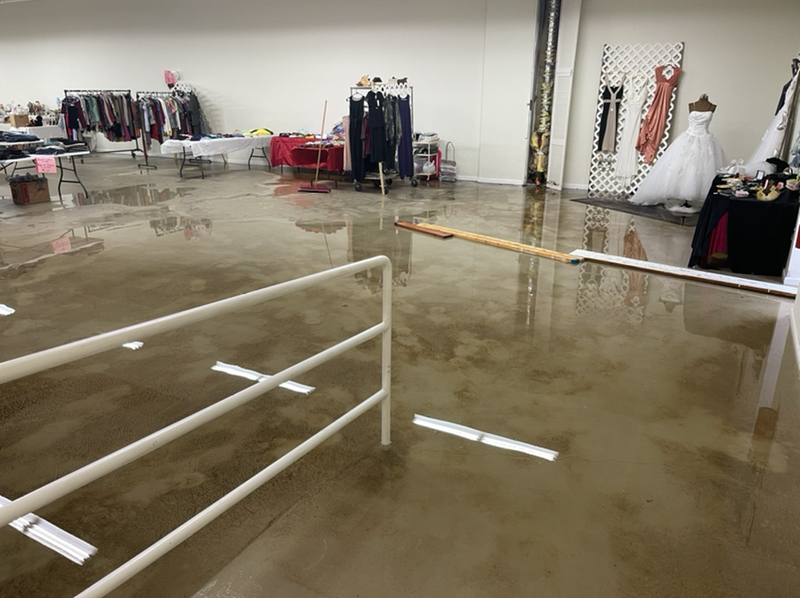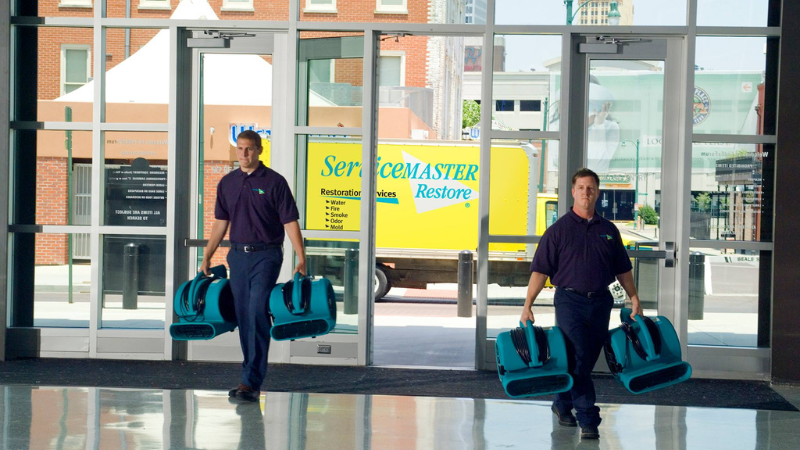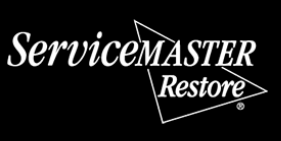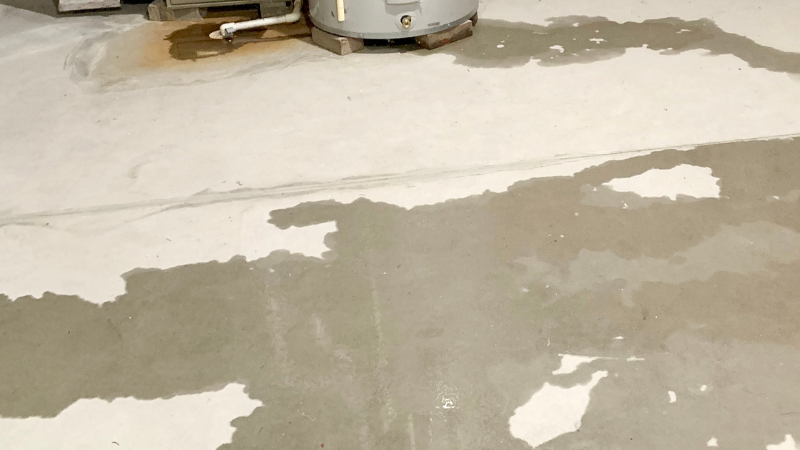Basement flooding is common. As the lowest part of the home, the basement is susceptible to heavy rainstorms, sewage backups, and even seepage through the walls. Cleaning the concrete floor after flood damage is important to maintain the basement and the home’s structural integrity.
What causes basement flooding?
The basement is prone to severe flood damage from a number of common causes. Sump pump failure is a major reason behind basement floods. Sewer backups can also catch homeowners off guard. Flash floods and groundwater flooding are additional reasons that basements flood.
Water heaters and hot water tanks are normally housed in the basement and when they fail, flood damage is likely. Leaky appliances, like washing machines, can also cause flooding. Homeowners who neglect to fix leaky pipes can expect flood damage in the basement.
The basement structure itself can lead to flooding. Flaws in the foundation, like cracks or leaks, allow water inside. A drainage system failure can be the culprit when the basement floods. Broken downspouts, clogged gutters, and gutter debris are often responsible for flood damage, too.
Why is it important to clean the concrete floor?
When any of the abovementioned scenarios cause flooding in the basement, it is critical to clean the concrete floor. Water that sits for prolonged periods on the floor can be hazardous. The smell of mildew, mold growth, and bacterial contamination can wreak havoc in the basement.
Furthermore, the homeowner risks shock danger from electrical outlets or appliances when the basement floods. If the water is contaminated, such as from a backed-up sewer water, the dangers multiply. Fortunately, if the water is clean, the homeowner can tackle a DIY cleanup.

What are the steps to cleaning the concrete floor?
Step 1: Remove standing water and debris
Firstly, remove as much water as possible. Use old towels or a wet-dry vacuum to absorb or extract the standing water. If floor drains are installed in the basement, use a squeegee to eliminate the water. Rent a sump pump to remove the water if drains are not installed.
An electric sump pump is not advised if the electrical panel is located in the flooded basement. If using an electric sump pump is desired, use a pump driven 12-volt auto battery. Alternately, a gasoline engine pump may be used to extract a large amount of standing water.
Be careful to avoid draining water inside the basement until the water outside of the walls has receded. Doing so helps to prevent the basement walls from caving in and the floors from heaving. Stop pumping when the water levels inside and outside are equal.
Depending on the water source, the floor may be polluted with mud or other debris. Shovel the mud after the water drains. Rinse the concrete with a high-pressure hose to remove silt and dirt stains. Scrub any stains on the walls using a stiff bristle brush and household detergent.
Step 2: Dry the concrete floor
A basement with concrete floors is easiest to clean and has the best outcome after water exposure. Dry the concrete floor as quickly as possible. Speed is recommended to prevent mold colonies and mildew from having an opportunity to grow and multiply.
Run several fans and dehumidifiers in the vicinity to speed up the drying process. Dehumidifiers work by extracting moisture from the air and reducing the amount of humidity. Unlike wood floors, concrete basement floors are safe from shrinkage even when quickly dried.
If the weather is temperate, open the windows and doors. Encouraging fresh outdoor air accelerates the evaporation and allows the existing moisture in the basement to flow outside. Leave an open box of baking soda on the windowsill to absorb moisture in the area.
Step 3: Clean and disinfect the concrete floor
Once the concrete floor is fully dry, the homeowner must clean and disinfect it. An all-purpose cleaner with bleach may be used with a clean mop for disinfecting the concrete floor. Or prepare an effective bleach solution by mixing ¾ cups of household bleach per gallon of water.
Cleaning the floor with a commercial bleach product or a homemade solution prevents bacterial growth. Persistent odors are also eliminated. If odors continue, place a lump of charcoal in an open container to absorb odors. Open the windows when applying a bleach solution.
As a fundamental part of the home, the basement should never be ignored. If the basement undergoes flooding, leaving the concrete floor wet invites mold—which is a costly issue to repair. Dry and clean the concrete floor as quickly as possible to protect the overall condition of the home.

Homeowners who are faced with a flooded basement can attempt to clean the concrete floor as a DIY task. But if the floodwater in your home or business rises to overwhelming levels, consult the water damage restoration experts at ServiceMaster Disaster Restoration and Recovery.
Our highly skilled technicians arrive promptly, assess the extent of flood damage, create a restoration plan, and begin work. We use cutting-edge water extraction equipment to remove the standing floodwater. Once the excess moisture is eliminated, we start the drying process.
The drying machinery our specialists use includes powerful dehumidifiers, hydroxyl technology, air movers, and floor mat systems. We inspect the property to ensure it is thoroughly dry, which prevents mold infestations and mildew growth that can worsen the flood damage.
ServiceMaster DRR technicians are experts in removing standing floodwater from any type of property, whether it is a residential home or a commercial building. No matter what caused the flood damage, we provide efficient and swift restoration services to protect the structural integrity of your property.
Home and business owners in San Francisco, California, rely on ServiceMaster DRR for quality flood damage cleanup. Whether you live in a flood zone or face a leaky appliance, our crews are available 24 hours a day for emergency flood cleanup at (800) 439-8833. Call us when a water damage disaster strikes.

Steve VanDenBerg is the owner of ServiceMaster Disaster Restoration and Recovery. He has over 30 years of experience working within the restoration industry and successfully leading start-ups, turnarounds, acquisitions and mergers, and rapidly growing companies.
Steve earned his BS in Business & Accounting from Calvin University in Grand Rapids, MI and began working for DSI Holdings as their Chief Financial Officer. When Steve began with DSI Holdings, they were running an underperforming ServiceMaster Restore franchise with one location. Steve implemented new policies and procedures for accounting and finance as well as a professional sales plan that increased profits eightfold over his time as the CFO. He was then promoted to President and CEO and in this time, he expanded the company from two locations with $4M in sales to 12 locations and $45M in sales. DSI Holdings became one of the largest disaster restoration companies in the U.S. and helped with major restoration projects throughout the U.S. and around the world.
Steve purchased ServiceMaster DRR in 2015 when the business was in decline. Drawing on his years of experience in turning around struggling ServiceMaster franchises, Steve overhauled our operations, including finance, sales, and marketing, which led to a quick turnaround. Within Steve’s first 24 months, sales increased by 60 percent. Steve also helped greatly improve our operating margins and established a relationship with California’s largest residential insurance company. Under Steve’s leadership, we have become one of the largest disaster restoration providers in California.
Steve has found great success in turning around struggling and stagnant restoration franchises by changing the business model and strategy, greatly increasing sales and profits. Many of the changes he has implemented have even been adopted by the franchisor into their operating model.



